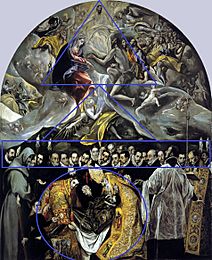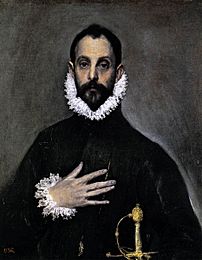Christ Carrying the Cross (El Greco, New York) facts for kids
Quick facts for kids Christ Carrying the Cross |
|
|---|---|
 |
|
| Artist | El Greco |
| Year | 1580 |
| Medium | oil on canvas |
| Dimensions | 105 cm × 79 cm (41 in × 31 in) |
| Location | Metropolitan Museum of Art, New York |
| Accession | 1975.1.145 |
Christ Carrying the Cross is a famous oil painting by El Greco, made around 1580 when he first moved to Toledo. The painting shows Jesus Christ carrying the cross on his way to be crucified. His eyes look up to the sky, showing he is thinking deeply about his sacrifice for everyone. His hands gently hold the cross, and a stormy sky fills the background. This painting is 105 by 79 centimeters. It is one of many similar paintings by El Greco and is now in the Metropolitan Museum of Art in New York.
Contents
El Greco: The Artist
Who Was El Greco?
Born in 1541 on the island of Crete, El Greco's real name was Doménikos Theotokópoulos. He got the name "El Greco" (which means "The Greek") while living in Italy. In Italy, he studied art in Venice with Titian, a very important artist of the Renaissance period.
After three years, El Greco moved to Rome. There, he continued to develop his own unique art style. He mixed ideas from the Byzantine era, the Renaissance, and the Mannerist era. To learn more about El Greco's life and art, you can click here.
El Greco's Special Painting Style
El Greco's paintings were truly special because he combined different art styles. He often painted figures that looked long and stretched out, almost like they were flowing. His art often showed strong feelings like suffering and love.
El Greco was also inspired by the Renaissance idea that a perfect human body could connect to God. However, instead of perfect bodies, El Greco often made his figures look a bit distorted. He used strong, emotional images to connect with a divine feeling. This focus on strong emotions came from the Mannerist art style.
Color was very important to El Greco. He often used deep, rich colors like navy, black, purple, and red. These colors helped show the emotions in his paintings and made viewers feel a certain way. His use of color created a powerful, almost otherworldly feeling.
The main goal of El Greco's painting style was to make the story, feelings, and message of each artwork very dramatic. He usually painted with oil paints on canvas.
Where the Painting Has Been
The painting, Christ Carrying the Cross, has been owned by several people over the years. Some of its past owners include Sir William Stirling Maxwell, General Archibald Stirling, and Lieutenant Colonel William Stirling. In 1953, Robert Lehman bought it. Then, in 1975, it became part of his collection at the Metropolitan Museum of Art in New York.
Today, you can see it in Gallery 958 at the Met museum.
Looking Closely at the Artwork
What the Painting Shows
In Christ Carrying the Cross, many small details help tell the emotional story. Christ's eyes show both a plea for mercy and an understanding of what is about to happen. The painting was inspired by Michelangelo's Risen Christ. It also connects to the Northern Italian way of showing the journey to Calvary. This style allowed artists to show Christ's human feelings instead of just his divine power. In this painting, Christ seems to ask for mercy while also understanding his role in God's plan to forgive people. This style also shows Christ as a single figure, separate from the crowd around him.
On the way to Calvary, Christ is carrying the cross to his own crucifixion in Jerusalem. This painting shows a moment where he stops during a storm to talk and reflect with the heavens before making the ultimate sacrifice for humankind.
Christ's Details
Many emotional details in this painting are seen in Christ himself. Here are a few details that help tell the story:
| Detail of the work: | Location: | Meaning: |
|---|---|---|
| Tears in Christ's gaze | Christ's eyes | The large tears show Christ both asking for mercy and accepting his fate. These tears connect to human feelings, showing his tenderness and how he relates to people. |
| Crown of Thorns | On top of Christ's head | The crown of thorns was placed on Christ's head to make fun of him. But now, it shows that Christ died as a king. The thorns and blood also represent the pain and torture he went through. |
| Implied line | Gaze to the heavens | An implied line is a suggested connection between two things. Here, Christ's eyes look up to the heavens. This strong eye contact creates a connection between Christ and God, right before his crucifixion. |
The Stormy Background
The background of Christ Carrying the Cross shows a huge storm with lightning, thunder, and possibly rain. The dark clouds make the mood of the painting feel serious and uneasy. Storms often make us feel fear and worry, which fits the human feelings shown in this portrait. However, there are also breaks of light in the storm clouds. This suggests Christ's acceptance of his sacrifice as he connects with the heavens.
Often, paintings of Christ are linked to a Bible story. In this case, the background reminds us of Matthew 8:23-27. In this Bible passage, Christ reminds his followers to have faith, even when things are difficult or scary. The painting shows the same message. Even though a storm rages in the background at a moment of death, Christ reminds us that God is always with us and with him. There is no need to doubt or be afraid when you trust in God.
Christ and Cross Symbols
This painting is a great example of religious art. It not only shows Christ, a very important religious figure, but it also includes ideas from Bible stories. As mentioned, the background connects to Matthew 8:23-27. The actual story of the crucifixion is told in all four gospels of the Bible: Mark, Matthew, Luke, and John.
See also
 In Spanish: Cristo abrazado a la cruz (El Greco, tipo I, Nueva York) para niños
In Spanish: Cristo abrazado a la cruz (El Greco, tipo I, Nueva York) para niños
- List of works by El Greco
Images for kids





